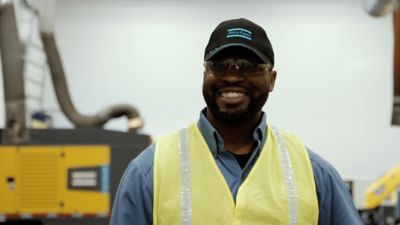Getting started: how to find the right blower for your site
Before you look at the technical details of a solution, it's a good idea to go back to basics. Looking at the data plate of your existing units will give you some information, but not the full picture. What is the current capacity you need at your site? How do you compare blower performance data? With a few guidelines, you'll be able to spot the best offer in no time.
Download your blower guide here
Download aeration blower request sheet below
If you want to check which blower solution we can offer for your wastewater application, feel free to complete and send us the request sheet. Our local experts are happy to explore which of our technology would be your right fit.
- Aeration blower request sheet imperial 754.8 kB, PDF
- Aeration blower request sheet metric 755.3 kB, PDF
The true cost of your aeration air
There are many ways to look at the cost of aeration air. The number of running hours plays a vital role in your purchase decision. But cutting costs goes beyond looking at the price tag of a new blower installation. Discover our tips for a more sustainable process.
Easy integration
Thinking about the installation of your air blowers might seem like something you do after you've purchased them. Thinking ahead will save you from unexpected costs. For instance, not all blowers are offered as complete packages. Making sure you have a complete package will ensure that everything you'll need for operation is included in your purchase. What are the hidden costs? What should be included before your blowers can be deployed into the treatment process?
Never run out of air
Minimizing emissions & breakdowns
Compressed air is an integral part of the wastewater treatment process. The first step towards a more reliable process is choosing the quality equipment that fits your needs. It's key to stay ahead of new governmental guidelines and regulations. The increasingly strict rules require your process to emit a minimal amount of carbon and the water to contain a minimal level of pollutants after treatment.
Optimal aeration control
Designing your aeration control system affects the efficiency of your process. More control means more knowledge and fewer chances of a complete breakdown. The more control you want, the more data you'll need. Traditional blower setups such as cascade sequences or unit control through gauges only allow simple measuring and control. Discover our tips and tricks to get more control over your system.
Minimal maintenance
Correctly maintaining your aeration installation ensures a smooth treatment process. Preventive maintenance is a great way toward a healthy installation. But taking the next step toward predictive maintenance will pay off in the long run. Discover how you can extend traditional service intervals and avoid those unwanted breakdowns.

Wastewater treatment applications
Digital brochures wastewater treatment & product
Wastewater treatment plants videos
Montville Wastewater Treatment Plant
The Montville Water Pollution Control Facility uses six Sequencing Batch Reactors (SBRs) to treat their wastewater. The influent flows have significantly higher loading than average due to industrial users from a paper plant and also a nearby casino due to those high loads. They need much more air than your average wastewater treatment plant. Atlas Copco met with Superintendent Derek Albertson about to discuss the application and why Atlas Copco’s ZB VSD+ blower was the perfect the needs of the facility.
Port Washington Wastewater Management
Located on the picturesque Lake Michigan shoreline, the Port Washington Wastewater Treatment Facility in Port Washington, Wisconsin chose Atlas Copco’s ZS VSD+ screw blower to power their facility 8 years ago. A few of the benefits they’ve realized with Atlas Copco’s blower and service solutions include 64,000 running hours Zero unplanned downtime Over $190,000+ in energy savings 24/7 Partnership with Service Technicians
Wastewater Treatment | Sainsons Paper Industries
Discover how Sainsons Paper Industry in India revolutionized their effluent treatment plant with Atlas Copco Screw Blowers. Witness the transformation as they replaced conventional root blowers with cutting-edge technology, ensuring an uninterrupted air supply for their water treatment process. Experience the success story of a promising investment that propelled their paper manufacturing sector forward. Watch now and witness the power of innovation at Sainsons Paper Industry.
Wastewater treatment plants stories




















